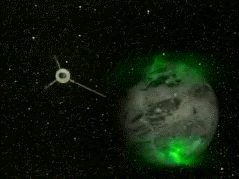
NASA Science News home |
|
|
"By timing the encounter to happen while Ganymede was in eclipse, we put Galileo in the right place at the right time to see auroras," said Dr. Eilene Theilig, deputy project manager for Galileo at NASA's Jet Propulsion Laboratory. Pictures from today's flyby will be transmitted to Earth during the next three to five months. Right: This frame from a JPL animation shows what auroras on Ganymede might look like as Galileo swings by the large moon. Credit: NASA TV. In its 29th orbit around Jupiter since 1995, the durable spacecraft dipped 2,337 kilometers above the surface of the darkened moon. "It looks like a nice, calm flyby," said Jim Erickson, Galileo project manager at NASA's Jet Propulsion Laboratory, Pasadena, Calif. "The team was prepared for problems, but we're happy without any. And we'll be even happier once we've passed this orbit's closest approach to Jupiter."
Today's flyby was a special opportunity to study something almost as hard to see as an underground ocean. With direct sunlight blocked by Jupiter, scientists hoped to record faint shimmering auroras on Ganymede, comparable to Earth's Northern Lights. "The auroral glows we plan to observe occur because Ganymede
has a very tenuous atmosphere of gases," said Dr. Torrence
Johnson, Galileo project scientist at JPL. "When these gases
are hit by electrons from Jupiter's radiation belts, they glow.
It's similar to what goes on in a fluorescent light bulb when
you turn on the electricity."
Above: A dynamic spectrogram of Ganymede's plasma waves. It shows intensity as a function of wave frequency (vertical axis) and time (horizontal axis). Scientists at the University of Iowa used the data to generate a audio signal shifted 9 times downward in frequency from the natural frequency range of the plasma waves (near 80 kHz). Click to listen: [3.9 MB Quicktime movie][1.3MB WAV audio] Credits: Galileo Plasma Wave Science Team led by Prof. Donald A. Gurnett, University of Iowa. Mapping auroral glows around Ganymede might reveal even more: The paths of electrons approaching Ganymede from Jupiter's radiation belts are determined by lines of magnetic force, explained Johnson, so the location of the glows triggered by those electrons might delineate the shape of Ganymede's magnetic field. Galileo's trajectory for today's Ganymede flyby once again exposed the orbiter to Jupiter's intense radiation belts, noted Erickson. With extensions to its original two-year mission, Galileo has survived three times the cumulative radiation dose it was designed to tolerate. Some of its 12 scientific instruments have been impaired by the radiation to varying degrees, but the spacecraft is still returning valuable scientific information. The effects of additional exposure next week cannot be predicted with certainty, Erickson said.  Above: Ganymede, which orbits Jupiter, is slightly larger
than the planet Mercury and more than three-quarters the size
of the planet Mars. If it orbited the Sun, Ganymede would surely
be considered a planet. Shown here in their correct relative
sizes are a Hubble Space Telescope image of Mars, a Galileo image
of Ganymede, a Mariner 10 mosaic of Mercury (the smooth stripe
represents an area of missing data), and a Galileo spacecraft
picture of the Moon. |



